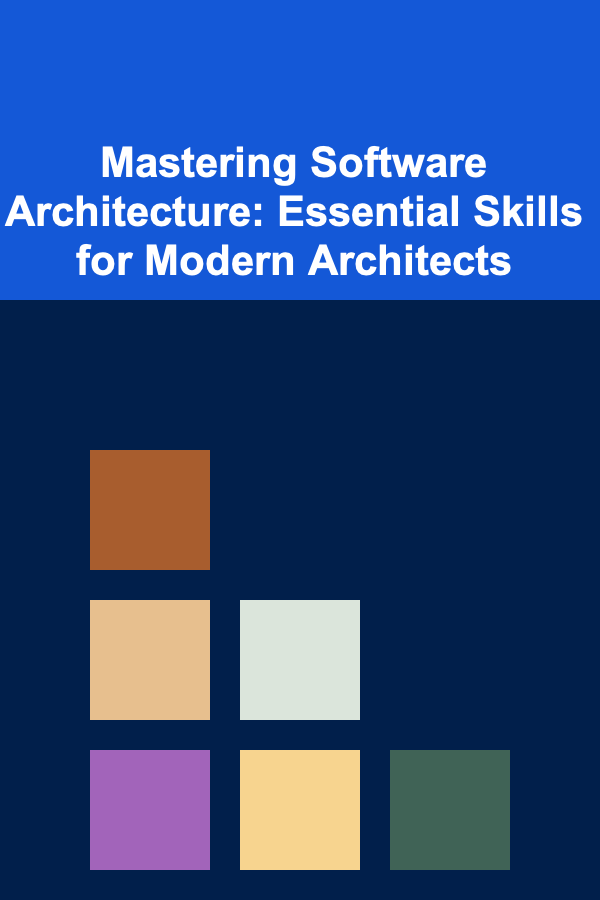
Mastering Software Architecture: Essential Skills for Modern Architects
ebook include PDF & Audio bundle (Micro Guide)
$12.99$5.99
Limited Time Offer! Order within the next:

Software architecture is the backbone of any successful software system. It's the discipline of designing high-level structures of software systems and the decisions that will guide their evolution over time. As technology evolves, software architects must continuously adapt to new methodologies, tools, and best practices to ensure their systems are not only functional but also maintainable, scalable, and efficient.
In this actionable guide, we will explore the essential skills every modern software architect must master to build robust, high-performing, and adaptable systems. We'll delve into both the technical and soft skills required, as well as explore how to stay ahead in a rapidly changing landscape.
Deep Understanding of Design Principles
Every software architect must have a firm grasp of core design principles. These principles help ensure the architecture is efficient, scalable, and maintainable. A deep understanding of design principles allows architects to make informed decisions, balancing trade-offs between various competing requirements, such as performance, scalability, and maintainability.
SOLID Principles
The SOLID principles are a set of object-oriented design principles that can improve the quality of software architecture:
- Single Responsibility Principle (SRP): A class should have only one reason to change. This ensures that a class focuses on a single responsibility, making it easier to maintain and understand.
- Open/Closed Principle (OCP): Software entities should be open for extension but closed for modification. This means that you should be able to extend a class's functionality without changing its source code, promoting flexibility.
- Liskov Substitution Principle (LSP): Objects should be replaceable with instances of their subtypes without altering the correctness of the program. This principle ensures that inheritance structures are well-formed and maintainable.
- Interface Segregation Principle (ISP): Clients should not be forced to depend on interfaces they do not use. This principle advocates for smaller, more specific interfaces, which increases flexibility and reduces unnecessary dependencies.
- Dependency Inversion Principle (DIP): High-level modules should not depend on low-level modules, but both should depend on abstractions. This principle helps in creating more loosely coupled systems.
Mastering these principles allows software architects to build systems that are easier to maintain, extend, and scale.
Separation of Concerns (SoC)
Separation of Concerns is a fundamental design principle that advocates for dividing a software system into distinct sections, each responsible for a separate concern or aspect. This leads to systems that are easier to test, debug, and extend. It can be applied at various levels, from microservices to modules and functions. By isolating different parts of the system, architects can simplify their development process, reduce the risk of introducing errors, and improve modularity.
Mastery of Architectural Patterns
Architectural patterns are reusable solutions to common problems in software architecture. They offer architects a framework within which they can design systems that are reliable, maintainable, and scalable.
Layered (N-tier) Architecture
In layered architecture, software is divided into layers, each responsible for a distinct concern. Common layers include:
- Presentation Layer: Handles user interactions.
- Business Logic Layer: Encapsulates the core functionality and business rules.
- Data Access Layer: Responsible for interactions with databases or external data sources.
Layered architecture promotes separation of concerns and makes systems easier to maintain by isolating changes to specific layers. This pattern is widely used in enterprise applications and is fundamental for building scalable systems.
Microservices Architecture
Microservices architecture is an architectural style where an application is developed as a set of small, loosely coupled services, each responsible for a specific piece of functionality. This approach has gained popularity due to its scalability, flexibility, and resilience. Microservices offer several advantages:
- Scalability: Each microservice can be scaled independently based on its workload.
- Flexibility: Microservices can be developed using different technologies, which allows teams to choose the best tools for each service.
- Resilience: Failure in one microservice does not affect the entire system, improving fault tolerance.
However, microservices also come with challenges, such as complexity in managing distributed systems, increased operational overhead, and difficulties in ensuring consistency across services.
Event-Driven Architecture
In event-driven architecture (EDA), systems are designed to respond to events. Components communicate through events that trigger specific actions. This pattern is particularly useful for systems that require real-time processing or need to respond to external triggers.
EDA supports:
- Decoupling: Components are loosely coupled and communicate asynchronously via events.
- Scalability: Event-driven systems can easily scale by adding more consumers for events or producers.
- Real-time Processing: Event-driven systems are ideal for use cases where immediate responses to changes in state are required, such as stock trading platforms, real-time analytics, or IoT systems.
Service-Oriented Architecture (SOA)
In SOA, applications are built as a set of loosely coupled services that communicate over a network. SOA allows for easy integration with third-party services and promotes reusability of components. It's a precursor to microservices and offers similar advantages, although it's often more monolithic in nature compared to the fine-grained structure of microservices.
Mastering System Design and Scalability
System design is at the heart of software architecture. A system that is not designed to scale is doomed to fail as demand increases. Modern architects must be able to design systems that are not only efficient but can also handle a growing user base, increasing data volumes, and varying traffic loads.
Horizontal vs. Vertical Scaling
- Vertical Scaling (Scaling Up): Involves adding more power (CPU, RAM) to a single machine to handle increased loads. However, this approach has limitations and can be expensive, as the cost of more powerful hardware increases exponentially.
- Horizontal Scaling (Scaling Out): This approach involves adding more machines or instances to distribute the load. Horizontal scaling is more cost-effective and is the preferred method for building scalable systems. Cloud services like AWS, Azure, and Google Cloud make horizontal scaling easier by providing auto-scaling capabilities.
Load Balancing
Load balancing ensures that requests are evenly distributed across multiple servers, preventing any single server from becoming overloaded. There are several types of load balancing:
- Round-Robin: Distributes requests evenly across all servers.
- Least Connections: Sends traffic to the server with the fewest active connections.
- Weighted Load Balancing: Assigns more traffic to servers with higher capacity or performance.
Caching
Caching is a critical technique for improving system performance. By storing frequently accessed data in memory (e.g., using Redis or Memcached), systems can dramatically reduce response times and database load.
- Application Caching: Store results of expensive computations to speed up response times.
- Database Caching: Cache database query results to reduce the load on databases.
- Distributed Caching: Use distributed caching systems to share cache data across multiple servers.
DevOps and Continuous Integration/Continuous Delivery (CI/CD)
Modern software architecture is closely tied to DevOps practices, which focus on collaboration between development and operations teams to deliver software faster and more reliably.
Continuous Integration (CI)
CI is the practice of frequently integrating code changes into a shared repository, where they are automatically tested and validated. CI helps to detect errors early, ensuring that developers can address issues before they become too complex.
Continuous Delivery (CD)
CD takes CI a step further by automating the deployment process. Code that passes tests is automatically deployed to production or staging environments, enabling teams to release new features or fixes at a rapid pace. CD reduces the time between writing code and delivering it to end users, ensuring that software is always up-to-date and minimizing the risk of human error.
Monitoring and Observability
A critical aspect of DevOps is ensuring that systems are continually monitored and that performance metrics are collected. Tools like Prometheus , Grafana , Datadog , and New Relic enable architects to gather insights into how the system is performing in real-time, allowing for quick identification and resolution of issues.
Soft Skills for Modern Architects
While technical expertise is paramount, soft skills play a significant role in the success of a software architect. Architects must communicate effectively with both technical and non-technical stakeholders, balance trade-offs, and ensure alignment with business goals.
Communication and Collaboration
Software architects must work closely with development teams, product managers, business leaders, and clients. Strong communication and collaboration skills are essential to ensure that the architecture aligns with the goals of the business, is feasible within technical constraints, and meets user needs.
Problem-Solving and Decision-Making
Architects often have to make tough decisions under uncertainty. They must evaluate trade-offs, consider long-term consequences, and prioritize solutions that meet the needs of both the business and the users. Effective problem-solving requires creativity, analytical thinking, and the ability to foresee potential challenges.
Leadership and Mentoring
As leaders within technical teams, architects must be able to mentor junior developers, provide guidance, and inspire their teams. Leadership involves fostering a culture of continuous improvement, encouraging innovation, and guiding teams through complex challenges.
Conclusion
Mastering software architecture requires a blend of deep technical knowledge and strong interpersonal skills. Modern architects need to understand core design principles, be proficient in architectural patterns, and have a solid grasp of scalability, performance, and system design. Additionally, they must embrace DevOps practices, continuous integration, and continuous delivery to ensure that their systems are not only built efficiently but are also continuously improved.
By honing both the hard and soft skills outlined in this guide, software architects can design systems that are scalable, maintainable, and resilient, while also staying ahead of the curve in an ever-evolving landscape.
Reading More From Our Other Websites
- [Personal Finance Management 101] How to Transition from Student to Professional Finances
- [Personal Care Tips 101] How to Choose Lip Gloss for Moisturizing Dry Lips
- [Organization Tip 101] How to Choose the Best Smart Thermostat for Your Home
- [Organization Tip 101] How to Create an Organized Home Office on a Budget
- [Organization Tip 101] How to Organize Sports Equipment in a Small Apartment
- [Organization Tip 101] How to Create a Dedicated Space for Hobbies and Crafts
- [Home Lighting 101] How to Create a Relaxing Lighting Setup for Your Bedroom
- [Trail Running Tip 101] Hydration Hacks: Balancing Electrolytes and Fluids During Mountain Mileage
- [Home Party Planning 101] How to Incorporate Fun Birthday Ideas into Your Home Decor
- [Organization Tip 101] How to Organize Holiday Decorations in the Family Room

How to Plan a Themed Party Based on Your Favorite TV Show
Read More
How to Soundproof Your Home for Better Music Enjoyment
Read More
How to Style Co-Ord Sets for Effortless Chic
Read More
How to Take Care of Your Home's Insulation for Energy Savings
Read More
Monetizing Deep Learning: A Guide to Earning Passive Income Online
Read More
Navigating the Complexities of HR Coordination: A Practical Handbook
Read MoreOther Products

How to Plan a Themed Party Based on Your Favorite TV Show
Read More
How to Soundproof Your Home for Better Music Enjoyment
Read More
How to Style Co-Ord Sets for Effortless Chic
Read More
How to Take Care of Your Home's Insulation for Energy Savings
Read More
Monetizing Deep Learning: A Guide to Earning Passive Income Online
Read More